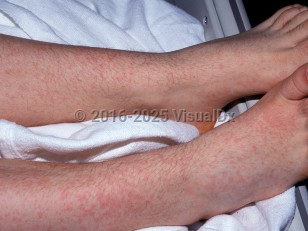Infection due to adenoviruses is common, and most humans are exposed to adenoviruses in childhood. The infection is acquired by respiratory droplets or by the fecal-oral route. There are many types of adenoviruses and clinical manifestations vary. Adenoviral infections can cause a wide range of disorders including cystitis, pneumonia, conjunctivitis, gastroenteritis, bronchitis, croup, pharyngitis, meningitis / encephalitis, the common cold, and undifferentiated febrile illnesses.
The severity can range from mild illness to severe and life-threatening infections (more common in immunocompromised hosts). Adenoviral outbreaks can occur throughout the year in settings with close contacts including nursing homes, rehabilitation centers, college dorms, and military barracks. Many infections are asymptomatic, and patients can shed virus for a time even after symptoms have resolved.
A specific viral diagnosis is often not necessary in immunologically normal hosts, as the disease is usually self-limited. The organism can be isolated using viral tissue culture. Viral DNA can be identified using the polymerase chain reaction.
There is no specific treatment for adenoviral infections other than supportive care. Prevention of infections and spread using strict adherence to infection control practices (contact and droplet transmission) is of vital importance to help reduce outbreaks.
Pediatric patients with hepatitis of unknown etiology: A 2022 outbreak of severe hepatitis in children in several countries, with the majority in Great Britain, may be associated with an adenovirus, including subtype 41F, but further studies are needed to determine the cause. Signs and symptoms include dark urine; jaundice; scleral icterus; light-colored stools; loss of appetite, abdominal pain, nausea, diarrhea, and vomiting; and joint pain. The US Centers for Disease Control and Prevention (CDC) has requested that physicians consider adenovirus testing for pediatric patients with hepatitis of unknown etiology and report any possible cases of hepatitis of unknown origin to CDC and state public health authorities. CDC also recommends testing for past or present SARS-CoV-2 infection in children with acute hepatitis, although the possible association is uncertain and under investigation. See also acute liver failure.
Adenovirus infection in Adult
Alerts and Notices
Important News & Links
Synopsis
Codes
ICD10CM:
B97.0 – Adenovirus as the cause of diseases classified elsewhere
SNOMEDCT:
25225006 – Disease due to Adenovirus
B97.0 – Adenovirus as the cause of diseases classified elsewhere
SNOMEDCT:
25225006 – Disease due to Adenovirus
Differential Diagnosis & Pitfalls

To perform a comparison, select diagnoses from the classic differential
Subscription Required
Best Tests
Subscription Required
References
Subscription Required
Last Updated:05/22/2023

